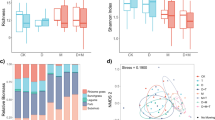Abstract
The pathway for the flow of salt-marsh grass production into marsh food-webs is still not well defined. We compared the abilities of three marsh macroinvertebrates [salt marsh periwinkles, Littoraria irrorata (Say) (=Littorina irrorata), salt-marsh coffee-bean snails, Melampus bidentatus (Say); and a talitrid amphipod, Uhlorchestia spartinophila Bounsfield and Heard] to access standing-dead leaves of smooth cordgrass (Spartina alterniflora Loisel). The invertebrates were incubated with naturally-decaying leaves, and the rates of removal of organic matter and living fungal biomass (ergosterol) were measured. The impact of invertebrate activity upon fungal growth rates was measured as rates of fungal-membrane synthesis (incorporation of radioacetate into ergosterol). The removal rates of organic leaf biomass per mg individual biomass were highest for amphipods (700 μg mg−1 d−1) and lowest for periwinkles (90 μg mg−1 d−1), but the relatively large biomass of the snails made their removal rates per individual greater than those of amphipods. Net removal of ergosterol by all three invertebrates was >50% for yellow-brown (early-decay) leaf blades. For fully-brown (advanced-decay) blades, >50% removal of ergosterol was found only for periwinkles; exposure to coffee-bean snails and amphipods resulted in a net ergosterol reduction of ≤20%. The lower net reduction of living fungal biomass by coffee-bean snails and amphipods may have been due to fungal-growth stimulation (2.3-fold stimulation in coffee-bean snails and 1.5-fold stimulation in amphipods). Grazing by periwinkles did not stimulate fungal growth, possibly because of its high intensity. Grazing by these three salt-marsh shredders may affect marsh-grass shoot-decay in different ways. Periwinkles may abbreviate the period of fungal production, and incorporate the decaying material relatively quickly into snail biomass and fecal-pellet rain to the sediments. Coffee-bean snails and amphipods may enhance and prolong fungal production, along with the formation of fecal-pellet rain. All three invertebrates fed preferentially on leaf blades rather than leaf sheaths, and feeding rates of gastropods were higher during the night than during the day.
Similar content being viewed by others
Author information
Authors and Affiliations
Additional information
Received: 25 November 1998 / Accepted: 4 November 1999
Rights and permissions
About this article
Cite this article
Graça, M., Newell, S. & Kneib, R. Grazing rates of organic matter and living fungal biomass of decaying Spartina alterniflora by three species of salt-marsh invertebrates. Marine Biology 136, 281–289 (2000). https://doi.org/10.1007/s002270050686
Issue Date:
DOI: https://doi.org/10.1007/s002270050686




